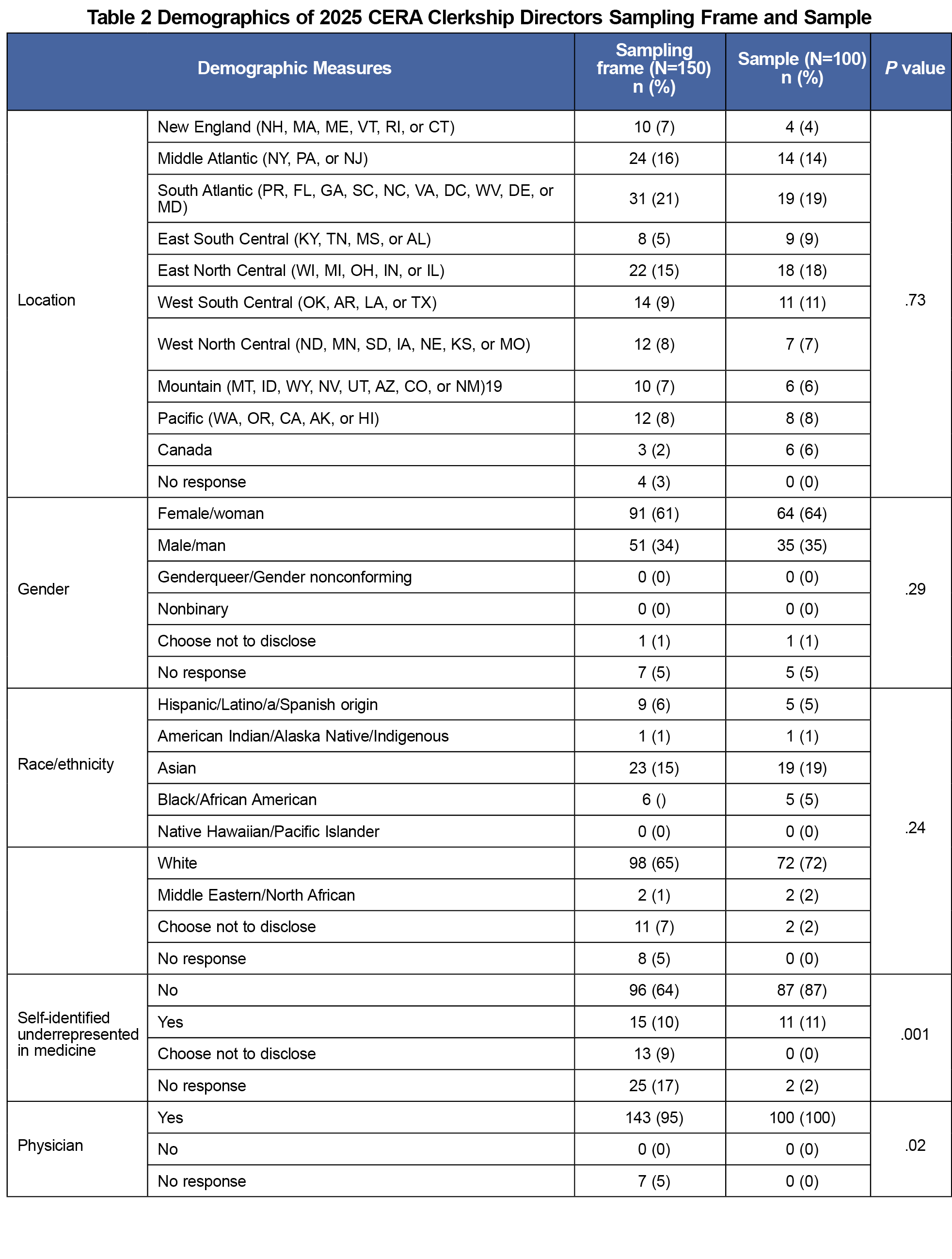Introduction: CERA, the Council of Academic Family Medicine (CAFM) Educational Research Alliance, is a collaboration between four family medicine organizations that conduct omnibus surveys of different academic family medicine groups. This paper describes the methodology of the 2025 Clerkship Director (CD) Survey and demographic results of respondents.
Methods: Four topics for the annual CD survey were selected via peer review after a call for proposals in early 2025. The survey was sent to clerkship directors via email from June 3, 2025 to July 11, 2025. The demographics of the sampling frame vs sample were compared with χ2 tests to determine if they were representative.
Results: One hundred eighty surveys were sent out; after receiving updated clerkship information, the final 2025 pool size was 174 survey recipients (161 in the United States and 13 in Canada). Although there are 43 DO schools in the US, the CD list maintained by STFM lacks these CDs. One hundred CDs responded for a response rate of 57.47%. We compared demographic data of the sampling frame with the sample. There were no significant differences in location, gender, or race/ethnicity. There was a significant difference in underrepresented in medicine status and being a physician.
Discussion: 2025 CD Survey respondents are representative of CDs. Few CAFM organization members submit to this survey and DO schools have not historically been included so are not represented. Targeted outreach to DO schools to identify their CD is planned prior to the launch of the 2026 CD survey.
The Council of Academic Family Medicine (CAFM) Educational Research Alliance (CERA), is a collaboration between the Association of Departments of Family Medicine, the Association of Family Medicine Residency Directors, the National Primary Care Research Group, and Society of Teachers of Family Medicine (STFM). 1 The intent of CERA is to provide infrastructure to support family medicine educational research that is both rigorous and generalizable. CERA’s goals are to increase collaboration, provide mentorship, and offer a clearinghouse of data for CAFM members to increase scholarly output.2
In addition to residency program directors, department chairs, and the general membership, CERA has conducted an annual clerkship directors (CD) survey since 2012.3 Results of CERA surveys have been disseminated as more than 226 published papers and 238 presentations. Our report presents the methods and demographic results of the 2025 Clerkship Directors Survey to assess for any potential response bias between the sample and the sampling frame. In addition, this report highlights an opportunity for improvement in generalizing CERA CD findings, namely that the CERA CD surveys have not yet included osteopathic medical schools. This is due to a lack of an existing list of these individuals and challenges identifying who they might be from publicly available data such as institutional website.
The methodology of the CERA Clerkship Director Survey has previously been described in detail.4 CAFM members were invited to propose survey questions for inclusion into the CD survey from January 2025 to February 2025. Five submissions were received and underwent peer review; four were accepted based on peer review rankings. Approved projects were assigned a CERA research mentor to help refine the survey questions. The resulting instrument was pilot tested via cognitive interview of an academic physician who was not part of the survey teams. The pilot testing process was performed by the survey director and resulted in additional question refinement.
Sample
The 2025 list of survey recipients included 180 clerkship directors (165 in the United States, 15 in Canada). This list was generated by starting with the 179 respondents to the 2024 CD survey and a survey to department chairs identified one additional clerkship director. The starting list did not include osteopathic schools.
One hundred eighty names were entered into the SurveyMonkey online survey platform; 13 emails bounced back with the initial email distribution of the survey, and one was marked as opted out of SurveyMonkey. Each of those 14 recipients were sent a specific invitation from the survey director’s personal email containing a unique link to the SurveyMonkey survey. During the time the survey was open for responses, 15 recipients indicated they were no longer the CD and 14 gave a replacement name and email. These newly identified CDs were then sent an invitation to participate in the survey. Five undeliverable email addresses were removed, yielding a final sampling frame of 174 survey recipients (161 in the United States and 13 in Canada).
We used the STFM membership database to generate demographics from the clerkship director sampling frame. This database contained demographics for 150 clerkship directors (147 in the United Staes and three in Canada). The remaining 25 email addresses did not have an STFM record, so there was no way to determine base demographics for those individuals. Therefore, demographic information is available for only 86.2% of the sampling frame. Overall rates of nonresponses for the STFM yearly demographic survey are as follows: credentials (4.6%), location of institution (2.67%), gender (4.67%), and race/ethnicity (5.33%). Individuals who responded to the CD survey were included in the sample even if they did not have demographics available from the STFM demographic survey. Existing STFM demographic information was not updated with responses from the CERA CD survey.
Survey Procedures and Analysis
The project was approved by the American Academy of Family Physicians Institutional Review Board in May 2025. The survey was open from June 3, 2025, through July 11, 2025. Nonresponders and partial respondents were sent five weekly reminders to respond with a final sixth reminder on last day the survey was open. The proportions of the location, gender, race/ethnicity and self-identified URIM status of the sampling frame vs. the sample were compared via χ2 tests.
Table 1 lists accepted topics for the 2025 CD Survey. Two topics address clinical documentation by medical students. One hundred-four surveys were returned. Three respondents only answered the initial question, "Are you the clerkship director?" and were counted as nonresponses. Of the recipients who indicated they were not the CD, one did so on the final day the survey was open and this was counted as a nonresponse since the there was no time for the replacement CD to complete the survey. Therefore, 100 surveys had complete data, for an overall response rate of 57.47% (100/174). There were no significant differences between the proportions of geographic location, gender, or race/ethnicity in the sampling frame and the sample. There were differences in the proportions of URIM status (P=.001) and physician (P=.02) holder between the sampling frame and the sample (Table 2).
The yearly CD Survey provides insight into topics of interest for undergraduate medical educators. A strength of the CERA survey is the ability to target a national audience of CDs in a structured format.5 This year’s CD Survey response rate of 57.47% aligns with prior years’ response rates and demographic analysis indicates the sample is representative of US and Canadian clerkship directors in the sampling frame for three of our five demographic areas. Interestingly, there were no statistically significant demographics differences for race/ethnicity, although there was a difference between self-identified underrepresented in medicine.
There are several limitations to note. CD demographics are limited to what is provided via STFM and are all self-reported. Self-reported demographics for STFM faculty members have a nonresponse rate below 5.33%. Furthermore, while demographic data of the CDs is important, it does not necessarily inform researchers about the demographics of the students and the institutions where they are located. We do not know if the CDs are representative of their locations.
Osteopathic medical schools have grown in numbers and size since the start of CERA, yet the list of clerkship directors has not included them. For the 2026 survey, targeted outreach to each DO school is planned to identify if they have a FM clerkship and who that director is. This will increase the representativeness of CD in the CERA survey.
Acknowledgments
Conflict Disclosure: Authors A.K., T.H., and R.B. are members of the CERA Steering Committee
References
- Shokar N, Bergus G, Bazemore A, et al. Calling all scholars to the council of academic family medicine educational research alliance (CERA). Ann Fam Med. 2011;9(4):372-373. doi:10.1370/afm.1283
- Mainous AG III, Seehusen D, Shokar N. CAFM Educational Research Alliance (CERA) 2011 Residency Director survey: background, methods, and respondent characteristics. Fam Med. 2012;44(10):691-693.
- CAFM Educational Research Alliance (CERA). STFM. Accessed October 11, 2025. https://www.stfm.org/Research/CERA.
- Kost A, Moore MA, Ho T, Biggs R. Protocol for the 2023 CERA Clerkship Director Survey. PRiMER Peer-Rev Rep Med Educ Res. 2023;7:30. doi:10.22454/PRiMER.2023.238868
- Seehusen DA, Mainous AG III, Chessman AW. Creating a Centralized Infrastructure to Facilitate Medical Education Research. Ann Fam Med. 2018;16(3):257-260. doi:10.1370/afm.2228





There are no comments for this article.